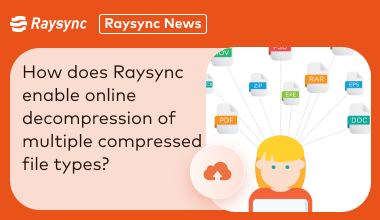What are the pros and cons of peer-to-peer transfer?
P2P transfer tools, as a new type of data transfer method, are becoming increasingly popular due to their ability to bypass traditional centralized server models, allowing users to transfer data directly between each other, significantly increasing transfer efficiency and speed. However, like all things, P2P transfers have their pros and cons. In this article, we detail the advantages and disadvantages of utilizing P2P transfer tools, using the Raysync transfer tool as a case study.
The Benefits of P2P Transfer Tools
Efficiency: P2P transfer tools can transmit data directly without the need for an intermediary node, resulting in faster communication speeds and lower latency.
Security: P2P transfer tools can prevent data being intercepted or modified during transmission, thereby improving data security.
Flexibility: P2P transfer tools can provide a variety of transmission modes according to user needs, such as uploading and downloading from local servers, point-to-point transmission, and bidirectional sync transfer, etc.
Easy Integration: P2P transfer tools can be seamlessly integrated into existing corporate systems, providing SDK, HTTP API, command line, network proxy, and other integration methods.
The Disadvantages of P2P Transfer Tools
1.Device Limitations: P2P transfer tools require direct communication between devices, thereby placing large restrictions on distance between devices. If the distance between devices is too great, or there are objects impacting the signal, it could affect the quality and stability of communication.
Connection Stability: P2P transfer tools require direct communication between devices; thus, stable connections are affected by things like distance between devices and environmental interference. If signals are unstable or other devices interfere, it could result in interrupted or failed data transfers.
Costs: Establishing a P2P network is challenging and expensive. If data transfers need to occur across areas or countries, it may require more resources and devices to ensure quality and efficiency of communication.
The Importance of P2P Transfer Tools
P2P transfer tools are significant because they provide a highly efficient, secure, and flexible data transfer method that can meet data transmission requirements across different scenes and industries, improving work efficiency and collaborative capacity.
Raysync (with a proprietary deployment solution, can also be connected to the public cloud, and corporate or organizational users can apply for a free trial) is a professional large file transfer tool. It uses P2P transmission technology, and also addresses the challenges and restrictions of P2P transfers, thereby achieving high-speed, stable, and secure file transfers. The improvements and benefits of Raysync include:
High-speed: RaySync uses the self-developed Raysync ultra-high-speed transmission protocol to overcome the limitations of traditional networks and hardware. It fully utilizes network bandwidth and provides ultra-low latency, high-speed, end-to-end output service. The transmission speed is nearly one hundred times faster, easily meeting the transmission requirements of large files and a large number of small files.
Security: Raysync incorporates advanced encryption and authentication technology to ensure files cannot be stolen or modified during transmission, thereby protecting the privacy and security of these files. Raysync also supports a comprehensive log audit strategy, complying with national laws and regulations.
Final Word
P2P transfer tools are software that use P2P network technology to transfer data. They have the advantages of high efficiency, security, flexibility, and also have limitations, such as device restrictions, connection stability, and cost. P2P transfer tools provide an efficient, secure, and flexible data transmission method that can meet data transmission requirements across different scenes and industries, improving work efficiency and collaborative capacity. Raysync is a professional large data transfer and file synchronization service for enterprises and is worthy of user trust and selection.
You might also like

Raysync News
April 12, 2024How does Raysync enable online decompression of multiple compressed file types?
Many compressed files are transferred to a file server. Users are unable to view or preview them. The ability to unzip files online on the server solves this problem and significantly improves the customer experience in a variety of ways.

Raysync News
November 3, 2022Product Update | Raysync New Function Released!
As the leader of high-speed large file transfer solution, Raysync announces its new key function of Admin Delivery Task. Click here to learn more!

Raysync News
May 20, 2020Problems Faced by Transnational Transmission
As the development of economic globalization and Internet, especially the development of Internet information technology, it is easy to transfer data across borders.